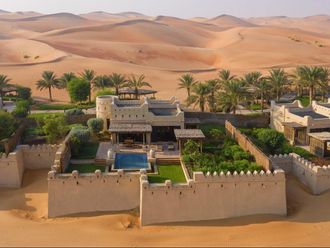Dubai: Dubai has developed an early warning system to monitor the movement of land and fluctuation in sea level in Palm Jumeirah to ensure the highest level of safety in the world’s largest man-made island.
The smart geodetic monitoring system comprises eight Global Navigation Satellite System (GNSS) stations, six inside and two outside the island, to measure horizontal and vertical movement of the land of the island, Dubai Municipality revealed at the 36th Gitex Technology Week.
Four sensors to measure water levels and water pressure and a complete weather monitoring station are also part of the system, which is first of its kind in the region, an official told Gulf News.
They are also linked to the early warning systems for earthquake monitoring and climate monitoring of the municipality.
“Data from all these will be sent to the municipality’s control room where we make an analysis and get immediate results. If there is any change, even small changes in micro millimetres in the height of the sand, it can be detected,” said Ahmad Mohammad Abdul Latif, principal survey system analyst with the Survey Department of the municipality.
Horizontal and vertical changes in the land and fluctuations in the sea water will be constantly monitored this way.
“If there is any significant change [in conditions of sea water or land] the smart system will send out warning messages to the decision makers.”
A mobile app that provides real time data is also used as part of the smart monitoring system. The app releases water data every minute while weather data will be updated every 30 minutes.
This will assure better safety for Nakheel’s flagship project, which is also an iconic landmark for Dubai. Government authorities, Nakheel and companies working in construction projects will benefit from the data and early warning system. The move is also part of efforts to attract and encourage investors and developers to the island and other similar projects in future.
“Both Palm Deira and Palm Jebel Ali are under construction. They may make use these data to improve their work over there,” said Abdul Latif.
He added that the municipality will compile the data readings every year for analysing the changes, if any, in the surroundings of the palm shaped island.
Salem Mohammad Al Bedawawi, the head of e-transform section at the IT department of the municipality said the geodetic monitoring system was one of the ways the civic body is making use of smart solutions for the development of the city.
“We are controlling and managing Dubai’s infrastructure. So we are using smart technology not just in services but also in operations,” he said.
Other smart solutions showcased at the municipality stand include a robotic monitoring system for the drainage network and QR coding for ghaf and palm trees.








